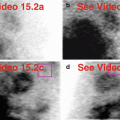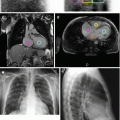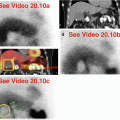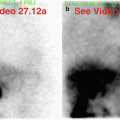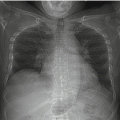and Vincent L. Sorrell2
(1)
Division of Nuclear Medicine and Molecular Imaging Department of Radiology, University of Kentucky, Lexington, Kentucky, USA
(2)
Division of Cardiovascular Medicine Department of Internal Medicine Gill Heart Institute, University of Kentucky, Lexington, Kentucky, USA
Electronic supplementary material
The online version of this chapter (doi: 10.1007/978-3-319-25436-4_16) contains supplementary material, which is available to authorized users.
The diaphragm is a large flat muscle that divides the chest and abdomen. Various conditions that affect the diaphragm may be identified on SPECT MPI raw projection image data (Table 16.1). The position of the hemidiaphragms should be noted during review. The left hemidiaphragm is a common vexing source of artifact on the reconstructed SPECT images.
Table 16.1
Differential diagnosis of “hot” and “cold” imaging findings related to the diaphragm
Organ system | “Hot” finding | “Cold” finding | References |
|---|---|---|---|
Diaphragm | Elevated liver (due to right-sided eventration) Elevated bile-containing stomach (due to left-sided eventration) Herniated small or large intestine | Muscular diaphragm (causes inferior wall attenuation artifact) | Burrell and MacDonald (2006) Chamarthy and Travin (2010) Friedman et al. (1989) Gedik et al. (2007) Hendel et al. (1999) Howarth et al. (1996) Pitman et al. (2005) |
When fluid is present on both sides of the diaphragm (as in pleural effusion with ascites), the hemidiaphragm(s) may be visualized as a soft-tissue structure outlined by surrounding “cold” fluid (Fig. 16.1). A high right hemidiaphragm may lead to a processing artifact when the liver is “hot” and adjacent to the heart (Burrell and MacDonald 2006). Normally, the dome of the liver has a smooth and curvilinear margin; surgical changes to the right hemidiaphragm may result in an irregular contour at the dome of the liver (Fig. 16.2). A high left hemidiaphragm may have “hot” stomach or small intestine, or even spleen or large intestine, immediately subjacent to it, leading to well-known problematic “hot” and/or “cold” processing artifacts in the inferior and inferior-lateral myocardium (Pitman et al. 2005). Eventration of the left hemidiaphragm leads to elevation into the chest with displacement of abdominal contents alongside the heart (see Fig. 22.5). Diaphragmatic hernias contain abdominal contents, including the stomach and small intestine (Chamarthy and Travin 2010; Gedik et al. 2007).
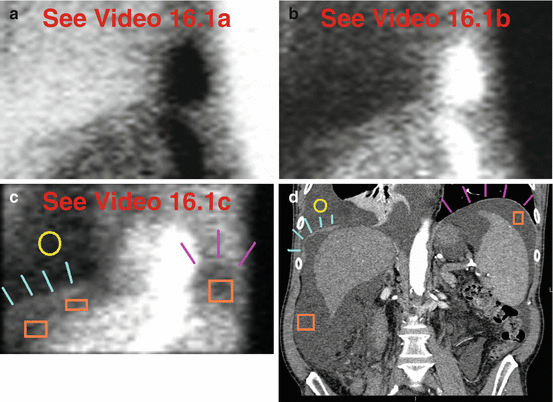
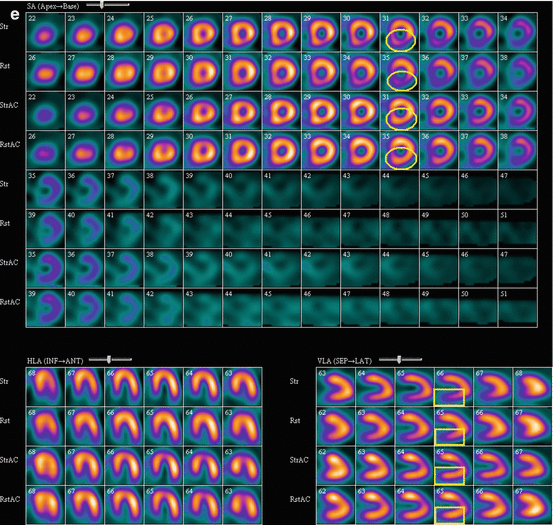


Fig. 16.1




Visualization of the right hemidiaphragm. A 61-year-old male awaits liver transplant. The right hemidiaphragm is outlined superiorly by a right pleural effusion and inferiorly by abdominal ascites (a–d). Right basilar atelectasis is seen (d). Note how the ascites and the left hemidiaphragm create a typical attenuation artifact in the inferior-basal wall (e).(a) Stress “black-on-white” raw projection images (Video 16.1a, frame 1), 99mTc sestamibi. (b) Stress “white-on-black” raw projection images (Video 16.1b, frame 1), 99mTc sestamibi. (c) Stress “white-on-black” raw projection image (Video 16.1c, frame 20), 99mTc sestamibi, right pleural effusion (yellow circle), perihepatic and perisplenic ascites (orange boxes), right hemidiaphragm (blue lines), left hemidiaphragm (pink lines). (d) Coronal CT image at level of posterior lower chest/upper abdomen, right pleural effusion (yellow circle), perihepatic and perisplenic ascites (orange boxes), right hemidiaphragm (blue lines), left hemidiaphragm (pink lines). (e) Stress/rest processed SPECT images (SA, HLA, VLA), fixed inferior-basal defect normalizes on AC (yellow ovals and yellow boxes on representative SA and VLA images, respectively)
Stay updated, free articles. Join our Telegram channel

Full access? Get Clinical Tree




